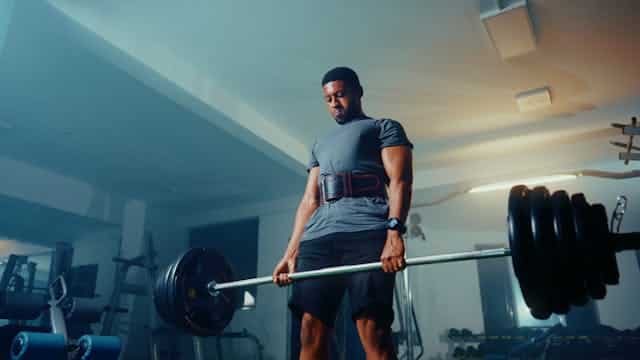At What Weight Should I Use a Belt for Deadlifts?
Deadlifts are one of the best compound exercises for building strength, power, and resilience, but they also place a high demand on your core and lower back.
As lifters get stronger, the question often comes up: at what weight should I use a belt for deadlifts?
A weightlifting belt isn’t a quick fix or a replacement for proper technique, but it can provide extra support and confidence when lifting near-maximal loads.
Knowing when and why to use one depends on your experience level, training goals, and individual needs.
By exploring the purpose of a lifting belt, the factors that influence its use, and the scenarios where it’s most effective, you’ll be better equipped to decide whether it’s time to add a belt to your deadlift training.
Ultimately, learning at what weight should I use a belt for deadlifts is about balancing safety, performance, and personal preference.
What is the Purpose of Weightlifting Belts for Deadlifts?
The main purpose of a weightlifting belt during deadlifts is to increase intra-abdominal pressure, which helps stabilize the spine under heavy loads. By giving your core muscles something to brace against, a belt reduces the likelihood of excessive spinal flexion and provides a safer environment for lifting heavy weights.
In practical terms, a belt can make you feel more secure, allow you to generate more force, and help you maintain proper posture throughout the lift.
Research shows that lifting belts don’t replace core activation; instead, they may even increase it by cueing your body to brace harder (Zink et al., 2001).
It’s important to remember that a belt is a performance and safety tool, not a substitute for proper deadlift mechanics.
If you can’t keep a neutral spine, engage your core, or lift with good technique, a belt won’t prevent injuries.
Instead, its role is to supplement an already strong foundation of form, giving you extra stability when you push your limits.
Factors to Consider When Determining if You Should Use a Belt for Deadlifting
If you’re on the fence about whether or not you should use a weightlifting belt for your deadlifts, taking the following factors into account may help you make an informed decision.
Lifting Experience
As a beginner, your goal should be to learn the basics of deadlift form and technique, allowing your body to build strength and core stability.
Using a belt at this stage may not be necessary since you’re looking to master the correct form instead of just relying on ‘training wheels.’
On the other hand, if you’re an experienced individual trying to apply progressive overload with heavier weights, having a belt around your waist can make the whole ordeal much safer.
It reduces spinal curvature and has major protective effects, which brings us to the next point (Fong et al., 2022).
Weight Being Lifted
With lighter weight, the spine and your core muscles aren’t in as much danger of sustaining an injury.
With heavier loads, however, a lot more power and stability are required of your core and spinal cord.
As a general rule of thumb, the heavier you lift, the more beneficial it may be for you to use a weightlifting belt.
Bear in mind that the concept of “lifting heavy” is subjective.
What’s heavy for one lifter may be light work for another.
So, it’s important to consider your individual strength and experience level when deciding whether or not you want to use a weightlifting belt.
As a general rule of thumb, lifters may find that using a belt becomes more beneficial as they approach higher percentages of their one-repetition maximum (1RM).
Injury History
Individuals with a history of back injuries or lower back pain may find that a weightlifting belt provides added support and confidence during deadlifts.
But, make sure you address any underlying issues and consult with a healthcare professional before relying solely on a belt to mitigate discomfort.
Technique and Form
Proper technique and form should always be the primary focus when performing deadlifts.
A weightlifting belt should never be used as a substitute for proper lifting mechanics.
If a lifter cannot maintain a neutral spine, engage the core muscles, and perform the movement safely, they may not be ready to incorporate a belt into their routine.
When to Use a Weightlifting Belt While Deadlifting

While there is no definitive answer to the question of when to use a weightlifting belt for deadlifts, several scenarios warrant consideration:
Depending on the Type of Deadlift Performed
Using a weightlifting belt can feel different depending on the type of deadlift you’re performing.
- In the conventional deadlift, a belt often provides the most noticeable benefit because it reinforces core stability when pulling near-maximal loads from the floor.
- With sumo deadlifts, some lifters find the belt less comfortable due to the upright torso angle, though it can still enhance bracing and hip drive when positioned correctly.
- In a snatch-grip deadlift, the longer range of motion and increased demand on the upper back mean that a belt may offer extra support, but some athletes skip it to focus on building raw strength and mobility.
- Deficit deadlifts, which already challenge bracing by forcing you to pull from a deeper position, may feel awkward with a belt for some lifters, yet others find it reinforces proper core activation.
Near Maximal Effort Lifts
During sets approaching or exceeding 85-90% of your 1RM, a weightlifting belt can provide added stability and confidence, allowing you to lift heavier loads safely.
At Your Personal Preference
The decision to use a weightlifting belt for deadlifts comes down to personal preference.
Some lifters may find that they perform better and feel more secure with a belt, while others may prefer to lift without one.
Experimenting with different approaches and listening to your body can help you determine what works best for you.
During Competition Preparation
If you compete in powerlifting or weightlifting competitions where the use of a weightlifting belt is permitted, it’s essential to train with one to acclimate to its feel and maximize performance on the platform.
For Back Support
Individuals who experience discomfort or instability in their lower back during deadlifts may benefit from using a weightlifting belt as a supportive measure.
However, it’s crucial to address any underlying issues and prioritize proper form and technique.
Final Thoughts: Should You Use a Weightlifting Belt for Deadlifts?

Weightlifting belts can provide valuable support and stability, but they should never replace proper form, consistent practice, and well-designed strength training.
Their real benefit comes when they are strategically implemented for heavy lifts, helping you push performance while reducing the risk of injury.
For lifters who are new to belts, it’s normal to feel some initial discomfort.
Fortunately, many designs now include extra padding or softer materials, with female models often tailored for a better fit and comfort.
Choosing the right belt can make the experience far more effective and enjoyable.
Working with a qualified coach is also an excellent way to maximize results.
Not only can they help you refine technique, but the benefits of personal training extend to guidance on when and how to use a belt in your program.
This combination of professional input and proper equipment ensures you get the most out of your deadlift sessions.
Ultimately, the decision to use a belt should be based on your goals, comfort, and experience level.
When applied correctly, it can be a valuable tool in long-term strength training progress.
This website does not provide medical advice. This website site does contain affiliate links, and purchases may earn a commission.
Read my Medical Disclaimer, Review Disclaimer, and Publishing Policies for more details. Use of this site indicates acceptance of these terms.



